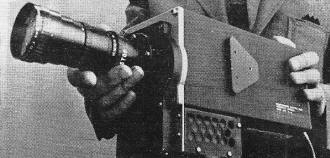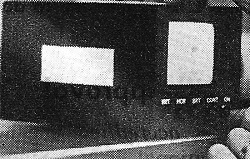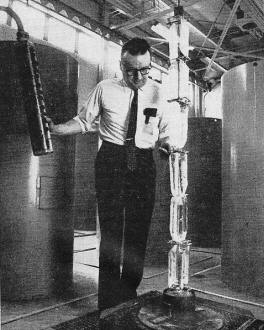|
August 1969 Radio-Electronics
 [Table of Contents] [Table of Contents]
Wax nostalgic about and learn from the history of early electronics.
See articles from Radio-Electronics,
published 1930-1988. All copyrights hereby acknowledged.
|
The recording and
transmission of color video today is accomplished entirely with semiconductor
sensors and digital circuitry. Yes, light levels are analog by nature (although
some would argue they are quantized, hence not truly analog), but the sensor
cells are addressed and read digitally. The data is then put into a digital
video transmission standard format for distribution either by cable or over the
air. In the early days of
color television,
a handful of system standards competed for universal acceptance (see list of
articles at bottom of page). Some were electromechanical and others were totally
electronic. One of the electromechanical schemes involved a rotating segmented
color wheel (red, green, and blue glass) in front of the vidicon tube and
assembling the detected light levels into a serial video train of analog signals
(aka composite video). Each segment of the signal has a set duration, so the
receiver knows how to decode the composite video timing and route the signals
(both audio and video) to the appropriate circuits and mechanisms. This setup
allows a black and white (B&W) camera to send color images. Believe it or not,
the video cameras deployed with Apollo 10 and Apollo 11 were of the color wheel
type. It spun in front of the vidicon tube at 600 rpm. Before laughing at the
crudity of the concept, modern day astronomers often use colored lenses with a
B&W camera to collect separate images which are subsequently combined in
software to produce a full color image. That is done because B&W sensors are
typically more sensitive and less noisy than color sensors, and the pixel
density is by nature 3x greater since each effective pixel does not require
separate red-, green-, and blue-sensitive pixel cells.
New & Timely - Apollo Video Cameras
 Apollo TV Uses SEC Tube Apollo TV Uses SEC Tube
Baltimore - The 15-lb color TV camera used aboard Apollo flights 10 and 11 is
almost identical to the unit being adjusted here by a Westinghouse project engineer.
Also shown is the 2 3/4-inch b-w TV monitor used by the astronauts to see what scene
was transmitted to earth.
The camera uses the field sequential system (New & Timely, July) in which
a rotating color wheel passing in front of the CRT provides separate red, blue and
green images that are converted to a single color image on earth.
 An important part to the color camera is a SEC
(secondary electron conduction) CRT tube that can pick up dimly illuminated scenes
invisible to ordinary vidicon TV cameras. An important part to the color camera is a SEC
(secondary electron conduction) CRT tube that can pick up dimly illuminated scenes
invisible to ordinary vidicon TV cameras.
The camera is about 17 inches long, including the 12.5-75-mm zoom lens. The aperture
stop range is f2.2 to f22, and focus range is 20 inches to infinity.
The color wheel just behind the lens spins at 600 rpm, and is divided into six
sections. Conversion equipment on earth provides a 30-frame-per-second rate for
the system.
Antenna Complex
A huge complex of antennas and transmitters is under construction in northern
Wisconsin to link the US with its military forces throughout the world. Dubbed Project
Sanguine by the Navy, the network could employ 250 powerful low-frequency transmitters
tied to a 70 x 100-mile grid of antennas if completed in the 1970's.
Sanguine's top-priority coded messages would be beamed into the ionosphere
and the earth's surface simultaneously. The ionosphere signal would encircle the
earth, while the ground signal could penetrate the sea to reach submarines.
If approved by Congress, costs of the project could exceed $1 billion due to
the expense of burying half the transmitters underground. Work on the first underground
station may start next year.
 R-Face Crystals Grown R-Face Crystals Grown
A rack of newly grown quartz crystals is removed from an autoclave where they
have grown for 27 days at 750° F. A series of 27 of the 12-foot-long tanks is
used at a Western Electric plant near Boston.
The new crystals are sliced into plates that can operate at 1 MHz. A different
technique is used to produce the crystals, which results in an R-face (rhombohedral)
structure. The R-face crystal can be used in communication applications to replace
expensive natural crystals.
Broadcasters and CATV Draft Transmission Pact
Washington - CATV companies can provide subscribers with the three nearest networks
and three independent stations if a draft proposal between the National Association
of Broadcasters and the National Cable Television Association is okayed by Congress
and the FCC. Acceptance of the proposal could provide most cities with a minimum
of six channels. Under the arrangement, CATV would pay copyright fees on retransmitted
programs, and also have a single channel for local broadcasting of sponsored entertainment.
Strongest Magnet Made
The latest claim to the strongest permanent magnet is being made by Raytheon.
Using a blend of cobalt and the rare-earth element samarium, Dr. Dilip K. Das developed
a material said to be four times as strong as most alnicos and twice as strong as
platinum-cobalt magnets.
Initially, the magnets will be used in the company's microwave tubes, where they
can replace up to four times their weight in previously used magnets.
The new material's energy product runs between 16 and 20 MGOe (million gauss-oersteds)
compared to 3 for ferrites, 5 for common alnicos and 10 for platinum-cobalt.
These merit figures include a magnetic substance's residual magnetism after a
magnetizing field is removed, and its ability to resist demagnetization in an opposite-polarity
field.
Dr. Das, framed by a metallurgical press, inspects a sample of the new magnet.
Color and Monochrome (B&W) Television
Articles
Posted September 12, 2023
|




























 An important part to the color camera is a SEC
(secondary electron conduction) CRT tube that can pick up dimly illuminated scenes
invisible to ordinary vidicon TV cameras.
An important part to the color camera is a SEC
(secondary electron conduction) CRT tube that can pick up dimly illuminated scenes
invisible to ordinary vidicon TV cameras. 
